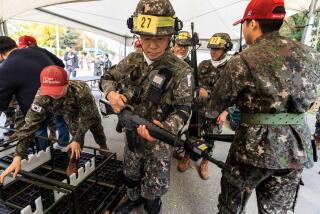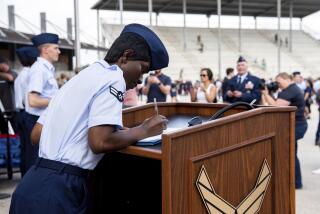COLUMN RIGHT / MARTIN ANDERSON : America Can Now Claim a Warrior Class : The all-volunteer force in the Gulf was an awesome fighting machine.
The Persian Gulf War has revealed that the United States now has something that other societies have had in the past--a warrior class. For the first time in our history a major war was fought entirely by troops who volunteered, by professional soldiers. Not a single, blessed draftee. They are now a victorious force, more than 5 million strong, whose core are the 2 million men and women who chose to make the military a career. When the welcome parties are over the reserves and the National Guard will return to civilian life, but not the regulars. They will go back to work--at a military base.
Since the United States abolished the military draft almost 20 years ago, we have argued and debated many aspects of the all-volunteer force--the degree to which it represented and mirrored our society, the number of high school graduates in its ranks, its racial composition, the number of women--but the central question, how well it would fight, was rarely raised and remained an unanswered question until Jan. 16, 1991. The world now knows the answer.
The all-volunteer force of America is an awesome fighting machine. President Bush was right when he called it “the finest fighting force this nation has ever known.” The men and women who fought in the Gulf were skilled and courageous, calm and cool under enemy fire, exemplary in their conduct and gracious in victory. They proved that men and women who freely choose military service as their profession are far better fighters than reluctant, sometimes sullen, conscripts.
Those returning troops are the beginning of a new tradition--the modern American version of the old samurai of Japan. Ironically, the Japanese name for their warriors was bushi . While our new warriors may rival the old samurai in the respect shown them and in their fighting prowess, there is one important difference. Our warriors are kinder and gentler, and have not shown the slightest inclination to lust for political power. But that potential always lurks where power and respect converge, and the degree of military influence in our society is something to watch carefully in the years ahead.
One little-known factor that contributed significantly to the superiority of the all-volunteer force, and to the creation of a new warrior class, is age. In some things older really is better. The Persian Gulf War is the first war America has fought with men and women instead of boys.
The median age of those who fought in Vietnam in the late 1960s was 21 years. Almost half of the troops in Vietnam were barely beyond being children, hastily trained, not even old enough to vote at the time. The average age of the men and women President Bush ordered to the Persian Gulf was 28 years. The average age of the enlisted men and women was 26 years. The average age of female officers was 30 years, male officers 32 years.
Seven years of maturity can make an enormous difference in a fighting force, and it did. Ever since President Nixon moved to end the draft in 1971, our military force has aged slowly and steadily, almost unnoticed. The troops who fought in the Persian Gulf were the result of 20 years of free choice, an armed force of mature men and women with the seasoned judgment, skill and seriousness of purpose that only seven extra years of living can bring.
It is true that many young men who were drafted in past American wars fought with distinction. But in relative terms there is no question about the overall combat capability of an all-volunteer force of grown men and grown women. No one has yet argued that the United States could have done what it did in the Gulf with hundreds of thousands of teen-age draftees. No one has ever argued that the might of the U.S. military would have been greater if we had had the draft for the past 20 years. And no one will. By the criterion of combat capability, the all-volunteer force has demonstrated its superiority to a conscripted force in the same compelling way that capitalism, by concrete example, demolished the idea of socialism.
There is one small hangover from our past infatuation with a military draft--draft registration. Spending $27 million a year to make computer lists of millions of teen-age boys was never a good alternative to a combat-ready force of men and women. Draft registration was irrelevant to the Gulf War, and now it stands as an insult to every man and woman who freely chooses the American military as a profession. One small thing we might do in honor of our returning heroes is to repeal this anachronism, and spend the $27 million a year on them instead.
More to Read
Sign up for Essential California
The most important California stories and recommendations in your inbox every morning.
You may occasionally receive promotional content from the Los Angeles Times.










